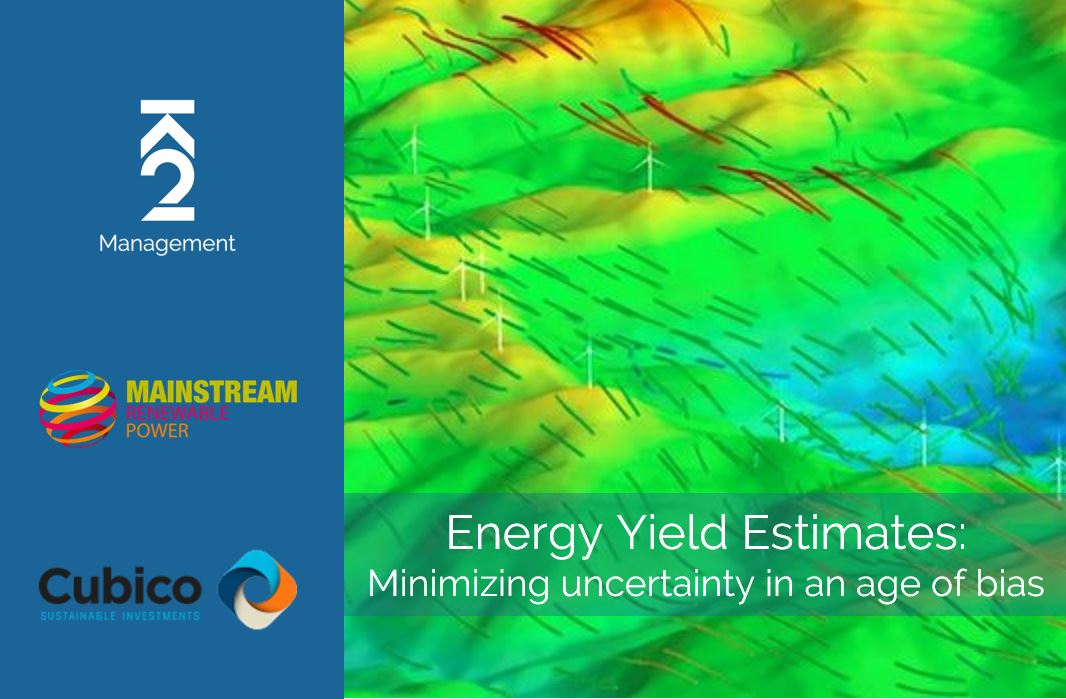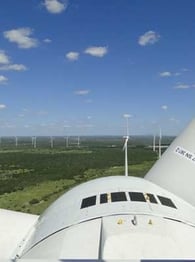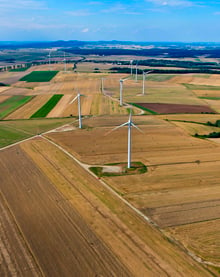
Energy yield estimates – Minimizing uncertainty in an age of bias
Global wind and solar development company Mainstream Renewable Power, leading renewables investor Cubico Sustainable Investments, and specialist consultancy K2 Management discuss removing bias and minimizing uncertainty in energy yield analysis.
It is not easy predicting the future so estimating the electricity you expect your wind farm to produce is a significant challenge. Such predictions are based on a range of complex numerical models and techniques; data from a wind measurement campaign (mast or lidar) and meteorological data is combined with wind flow and wake models, turbine power curves and assumptions of turbine and project performance to predict the expected long-term energy yield. The accuracy of methods is improving as the industry matures but at K2 Management we always strive for improvement.
“Our experience is that a large proportion of historical preconstruction wind yield estimates have been optimistic and that the industry has been slow to address this issue,” says Jack Marriott, Energy Analysis Manager at Cubico Sustainable Investments. Cubico, the investor, owner and operator of more than 3GW of wind and solar projects across the Americas and Europe, has its own department to underwrite energy yield estimates on investment targets.
 “It is hard to predict actual on-site wind turbine performance, particularly in complex or forested terrain or unusual wind regimes, and this is likely a contributing factor in cases of overprediction. Analysis of the older generations of wind farms indicates that the industry has been gradually reducing the gap between preconstruction estimates and real performance, but there is still more to be done, particularly for newer (larger) turbine types and more complex site terrain or wind climates. In addition, market forces including increasing levels of competition tend to put upwards pressure on energy yield estimates,” Marriott explains.
“It is hard to predict actual on-site wind turbine performance, particularly in complex or forested terrain or unusual wind regimes, and this is likely a contributing factor in cases of overprediction. Analysis of the older generations of wind farms indicates that the industry has been gradually reducing the gap between preconstruction estimates and real performance, but there is still more to be done, particularly for newer (larger) turbine types and more complex site terrain or wind climates. In addition, market forces including increasing levels of competition tend to put upwards pressure on energy yield estimates,” Marriott explains.
Ivar Rush, Director of Analysis Services at K2 Management continues, “At K2 Management we focus heavily on accuracy. We strive to continuously improve our models and when possible, we benchmark them against actual performance once projects go live. This knowledge gets fed back into our models, validating our methods and minimizing bias to provide the most accurate answer possible”
Mark Pearson from Mainstream recognizes the importance of validation in predictions:
“As a developer we are interested in a high degree of accuracy. Over the years I have seen variations +-5 percent in yield predications estimates for the same site. This variation can heavily affect a project’s business case. For this reason, we are interested in defendable predictions, technical rigor and use of validated methodology.”
The uncertainties in a prediction also need to be considered carefully. Ivar Rush explains “Learning from operational sites helps minimize bias, however uncertainties still exist in each step of an energy yield analysis and can vary hugely between projects. The uncertainty can be minimized but not eliminated. They are reduced by more and taller measurement masts, good quality instruments, and well validated modelling methods suited to the terrain and wind regime. The overall uncertainty defines the confidence in a prediction. Developers tend to focus on a project’s P50* but this can be risky if a project has high uncertainties. However, investors and banks will take the error bar into consideration in order to manage this risk, typically looking at the P75* and P90* respectively”
 Mark Pearson has a strong understanding of uncertainty from his role working as an Energy Analysis Group Manager at Mainstream for the last 10 years, so expects different levels of accuracy as a project develops.
Mark Pearson has a strong understanding of uncertainty from his role working as an Energy Analysis Group Manager at Mainstream for the last 10 years, so expects different levels of accuracy as a project develops.
“Often when we start out, there is a slice of land or a plot of sea. Early stage feasibility studies do not require the same level of scrutiny as when you approach commercialization, where different parties expect different confidence levels. We always strive to make as good and documented decisions as early as possible in our project development phases. This approach pays itself back later during the project, as making good decisions early on will save a lot of headaches and money. Ultimately, your choice of measurements, model and methodology will give you a competitive edge,” Pearson explains.
Through continual improvement of methods via validation, eliminating bias is possible, resulting in zero error on average when looking at a number of projects. However, uncertainty, no matter how small, will always remain for pre-construction energy assessment and prediction may deviate from actual production on a single site.
However, once a project is constructed the situation changes, Marriott notes. “Once you have more than a year or two of actual production data you can base your future performance model of the wind farm on the real historical performance. This removes much of the preconstruction uncertainty, providing greater confidence in the prediction over the remaining lifecycle.”
“By knowing how your turbines react to conditions on-site you can gain insights, and while improvement is not a given, more detailed analysis of operational data can point towards things like yaw misalignment, rotor imbalances or other power performance issues, which may present an opportunity to optimise the project. What is important is that we can provide our investors with a more accurate picture of the returns they can expect from our assets and we can then update our business model accordingly,” Marriott concludes.
Knowing this, Ivar Rush has further advice for wind farm investors.
“Developers and investors can further mitigate the pre-construction uncertainty by agreeing to a true-up mechanism. This can be based on the results of an operational energy yield analysis carried out once the wind farm has been operating for a significant period of time. At this stage the energy yield and hence project value can be calculated with the lowest uncertainty using the operational data and all stakeholders can be confident of receiving the true value of their contribution”.




